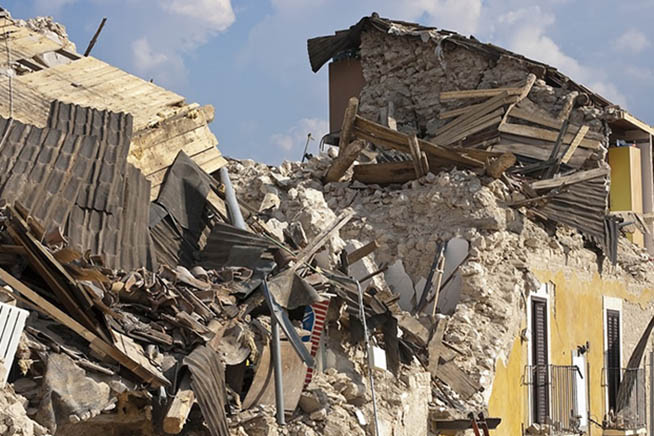A U.S. research is trying to exploit the GPS systems of smartphones to warn in time the population of an imminent tremor coming
Italy has started to tremble again. Our country, unfortunately, does not have centralized systems able to warn people of the arrival of an earthquake as already happens in two areas of the world highly seismic as, for example, Japan or California (USA): a handful of seconds can save many lives.
The tool in question is the Earthquake Early Warning (EEW) - earthquake early warning system also known as ShakeAlert - which is based on a large network of motion sensors, placed in strategic points, which as soon as they detect a tremor communicate instantly with a specialized alert center that calculates the severity of the phenomenon and provides to warn - via cell phone - the population up to 30 seconds before the arrival of a shock. The idea of the team of Californian researchers is to create a vast network that offers similar results but using, instead, the GPS of smartphones and the power of crowdsourcing.
How the rapid earthquake alert system works
Before illustrating the results of the research of Californian scientists - led by Professor Sarah Minson of the California Geological Survey in Menlo Park - it is perhaps appropriate to explain how an earthquake works. An earthquake is virtually impossible to predict, it is clear, but when it occurs, it is not an immediate phenomenon because it takes time - very little - to propagate. And it is precisely this handful of seconds that the Early Warning System (EEW) uses to warn the surrounding areas most at risk. When a seismic tremor occurs, in fact, two types of main waves are generated: the primary waves that, as the name suggests, are the first to be detected by sensors and seismographs, followed by secondary waves, slower - it is true - but much more dangerous because they cause the greatest deformation of the ground. Il sistema di allerta rapida si affida ai sensori per rilevare le onde “P” e cerca avvertire (anche solo una manciata di secondi prima) la popolazione delle zone a rischio dell’arrivo del sisma, ossia delle onde secondarie, fornendo una serie di altre utili informazioni come, il tracking in tempo reale delle onde sismiche dall’epicentro, stima dei secondi che mancano al verificarsi del terremoto e magnitudo stimata della scossa. Si tratta, nella migliore delle ipotesi, di poco più di 30 secondi, ma che possono fare la differenza tra la vita e la morte.
 Fonte foto: web
Fonte foto: web
Il Sistema di allerta rapida di terremoto (EEW), è un sistema di avviso di terremoto imminente in uso in alcuni paesi altamente sismici
L’unione dei GPS fa la forza contro il terremoto
Il problema è che un sistema di allerta rapida di terremoto di questo tipo è estremamente costoso, ed è qui che entrano in gioco i GPS dei cellulari. Tutti siamo abituati a usare il sistema di navigazione satellitare per scoprire dove siamo o per farci guidare a destinazione. Pochi, forse, sono a conoscenza che uno smartphone è talmente sensibile da registrare movimenti orizzontali e verticali della grandezza di un centimetro, esattamente il tipo di movimento che innesca – in caso di terremoto – i sistemi di allarme più sofisticati. L’idea dei ricercatori californiani è quello di sviluppare un’applicazione in grado di individuare questo tipo di movimenti su un numero sufficientemente adeguato di smartphone – escludendo così eventuali falsi positivi – e inviare in automatico un alert per avvertire la popolazione dell’imminente scossa e fornire il tempo per mettersi in salvo.
 Fonte foto: Pixabay
Fonte foto: Pixabay
Abitazioni distrutte dal terremoto
È un sistema che potrebbe funzionare?
I ricercatori californiani – che hanno pubblicato i risultati della loro ricerca sulla rivista Science – ne sono convinti dopo aver effettuato degli appositi test tramite un Google Nexus 5 simulando una scossa di magnitudo 7 e una di scala 9. Gli smartphone hanno reagito registrando in modo efficace già le scosse iniziali di magnitudo inferiore. This system is even able to locate the epicenter of the seismic event from the magnitude of the Earth's surface motion, i.e., the devastating one that follows the jerk waves. The main problem is "discarding" false positives. There's not much difference between an earthquake and a user jogging or a car ride on a bumpy road for a smartphone. But the solution is by no means impossible or expensive to solve: all it would take is to update the firmware and software on the cell phones of users living in seismic areas, or "hack" them. And that's what scientists plan to do in Chile to start collecting raw data with the aim of analyzing the information collected to eliminate precisely the false positives. Users don't have to change smartphones and local authorities don't have to shell out anything. All that's needed, in short, is an agreement with the manufacturers who must release a software update.
(opening video taken from YouTube)
Some of the videos in this section were taken from the internet, thus rated public domain. If the subjects present in these videos or the authors have something against the publication, it will be enough to make a removal request sending an email to: [email protected]. We will provide to the cancellation of the video in the shortest time possible.
